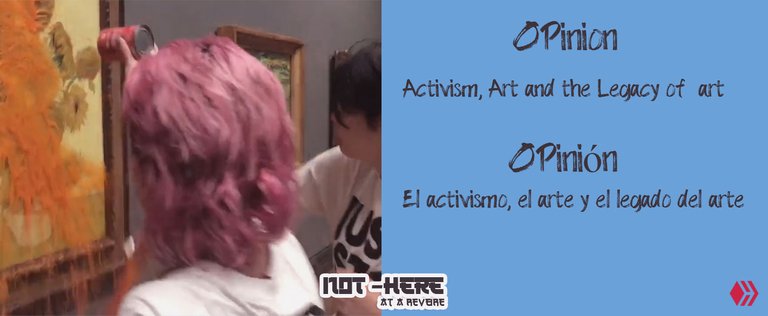
Source

🔤 English 🔤
Hello friends!
I hope you are well, and with time, because in today's post I would like to open a conversation with you, for those who do not know, I love the humanities, the condition and conditions that humans have generated in their history, I find it a very interesting object of study, and when these events of environmental activism occurred, about famous art paintings, I wanted to talk to someone about this topic, Maybe you think it's a little late to comment on these events, but the truth is that a lot of activism is still happening; but what really matters to me is to understand the situation and to emphasize why this event is important to study to understand the society in which we live!Here you can see the tweet made by the ONG, in case by any chance you had not seen it, or were not yet aware of the issue!

On the need to make a fuss:
A very obvious element that was present in the minds of the organizers of this activity; was scandal!, we live in a society of spectacle! Where, yes, something does not seek to attract attention in an extraordinary way, it will go unnoticed.
But the first point I want to bring up is that it is very difficult to express oneself in a concrete way when the attention is generated through a spectacle. It seems that the activists, or the ONG as such, have nothing against art, its legacy or its importance, and I believe them. But even if they argue that the purpose of the protest was to raise awareness; that art appreciation would be useless in a collapsed society, I believe that the idea behind this protest was to get attention, to get a viral clip that they could share and generate a huge presence.
Attacks against works of art or activists making flashy scenes in the name of their cause are nothing new, and the criticism of the banality of art appreciation has been explicitly criticized for at least the last 105 years from the art scene itself, with movements such as Dada or postmodernism.
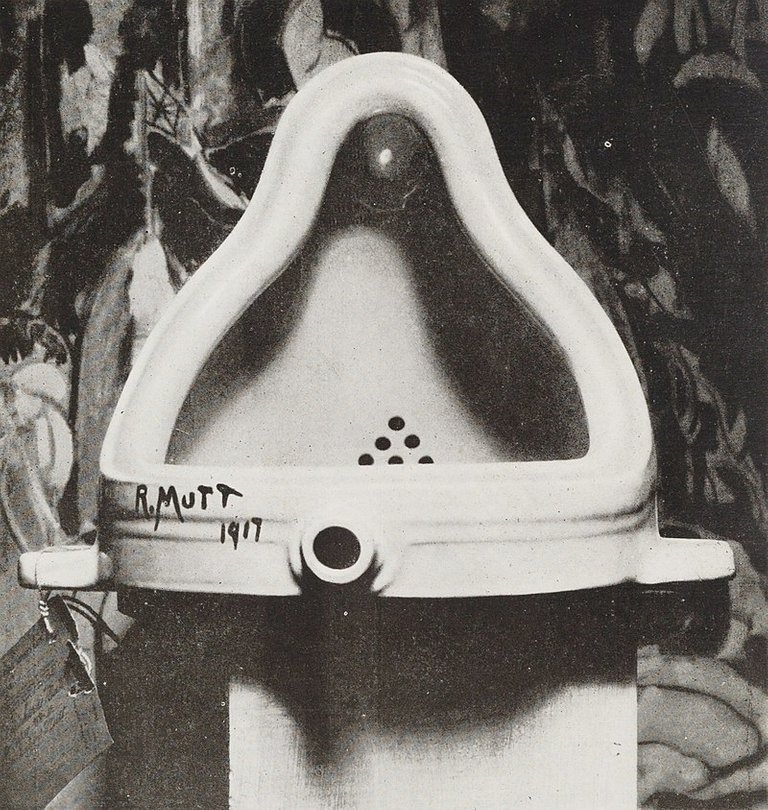
Source
Therefore, I feel that this event on October 14 was more focused on generating reactions than reflection, but this is nothing new, it is part of the times we live in, where sensationalism can distract from an important point that needs to be highlighted!
It is very difficult to generate awareness when attention is generated through scandal. The root of the problem is that if there is no scandal, there is no attention; it is a serpent of uroboros, because the scandal distracts from the point you want to make, but without scandal they don't pay attention to you.
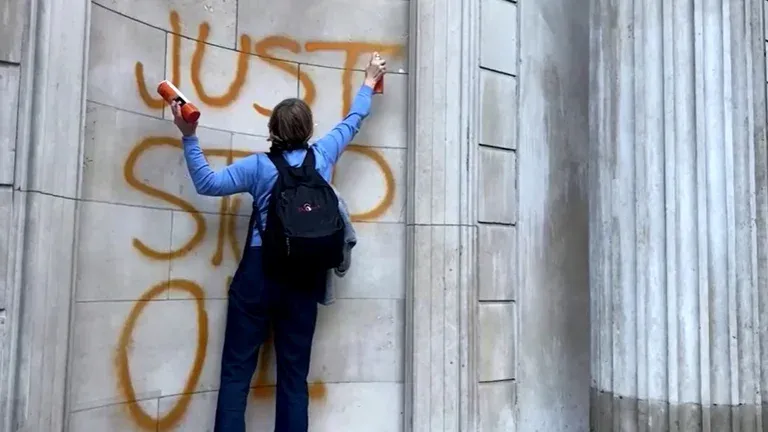
Source
With the above in mind, and considering that the movement is still active in performing, whether with figures representing royalty, government, or other works of art, I think it would be objective to ask ourselves the following questions:
Is it effective? - Will such flashy acts achieve any material or ideological change in the government or business landscape that will generate positive results?
Is it coherent? - Is it necessary to involve the museum or art world, or cultural heritages, with the current problem caused by the use and abuse of fossil fuels?
Is it effective? - Will such flashy acts achieve any material or ideological change in the government or business landscape that will generate positive results?
Is it coherent? - Is it necessary to involve the museum or art world, or cultural heritages, with the current problem caused by the use and abuse of fossil fuels?

On the subject of the environment, this is not the first time that a premeditated scandal is carried out, the first viral and paradigmatic case was that of Greta Thunberg, which was made in a parliament, years ago; I clarify that I have no intention at any time, to make judgment, or assumption of their "true intentions", as I will not do it of the activists of the vangoh flowers, previously mentioned. What I am going to question, beyond whether there are political interests involved or anything else, is the effectiveness or necessity of these media acts.
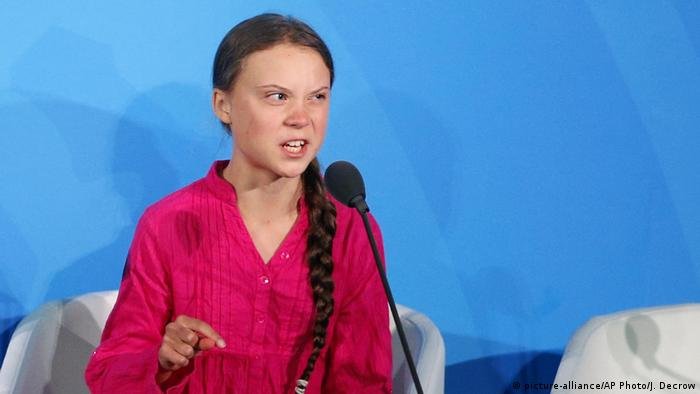
Source
And I think that the discussion on how fossil fuels are exploited is important, and it is super necessary that attention is directed to this, just google, approach the subject, you will be impressed and even worried to see the conditions in which the planet is, but I reiterate my previous doubts about these acts, is it enough?, will the debate on how these fuels can be managed without drastically affecting the economy or productive capacity of a country advance, because they are complex discussions. The European countries that have already started to make leaps towards renewable energy (those that have better possibilities with better infrastructures), do not make the complete leap, because it is a complex political task, which would affect the competitiveness that the country has and the competitiveness of companies that reside in the country, all the inhabitants, both workers and non-workers would have to go through a whole new process of adaptation, and this brings discomfort in the people, something that no political party will want to play, because for better or worse, every political party is oriented is mainly to maintain its power.
So, let's understand that activists have no real power to change, even if they managed to orchestrate a flashy, coherent, easily digestible act, they would still be tied to calling on the people to force an energy revolution.
Proposals like "The Big Reset" are already out there, in the eyes of world leaders, scientists and politicians are already referencing them in important meetings, talking about how future wars will be fought over water and natural resources. But the picture keeps getting worse. And I feel that the spectacles of attention-getting protests will continue to grow and evolve; and probably prove to be just as effective as the previous ones.

In defense of the use of the art world in activism:
The activists' proposals may seem to be an indirect correlation, but most of the arguments I have seen against these acts are based mainly on slippery slopes (reference to the fallacy) and romantic correlations about the feeling of a dead author or an ideal of disinterested art wrapped in a divine or mystical aura.
It should be emphasized that the activists communicated that they always took into consideration the state of the works of art, and that they would not have carried out the attack if it had destructive consequences on the paintings. They themselves affirm that the intention of the act was to draw the attention of the public.
Here are the most valid arguments I have found:
- The possible inspirations that may be evoked by these activists. Where some young people, (although it has not yet been the case) replicate these activities without so much consideration and end up permanently affecting any other work of art or historical heritage.
- They can also be blamed for the reinforcement of security measures, which I suppose will be installed in the museums from these precedents; thus limiting the interaction of the public with the exhibited works.
It is important to point out that the intrinsic value of an artistic work, in our current era, is not tied to the existence of the work itself, but to the understanding and contextualization that it had when it arose, in the era in which it arose; these works of art are and will continue to be for us, things of the past that have fulfilled and satisfied their first need. And bringing up the capacity of reproduction, compilation and even cloning that exists today, and the possibility of saving information virtually and to a certain extent eternally. They turn any argument about the loss of a work of art into triviality, as the loss of the last vestige of a historical heritage.
Or the appreciation of Greek art has been lost, where the later Roman copies and versions are, in almost all cases, the only reference that has reached our days of the lost originals.
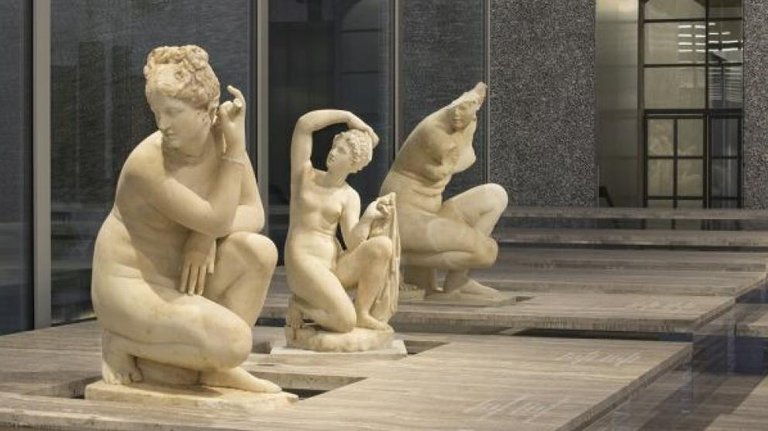
Source
The legacy of these artists close to our time is more than assured for the future.
Adorno points out that mausoleum and museum not only share phonemes, museums are traditional burial places for works of art, and bear witness to the culture and history from which they originate; they are treasures of humanity, relics that show us the artist's perspective of his own time. The moraliza or the sunflowers of Vangoh are not admired in museums! Because what you see is so "immense" that the human mind cannot bear it!
However, I support the idea of no longer seeing the museum as a commercial center, in recent decades, more than ever, the commercial and the museum have a clinging intimacy and this is the main reason why activists decided to confront the commodification of the work of art. Museums show us the evolution of our historical evolution, both from the point of view of aesthetics and the direct relic of the past, remember Hegel, when he points out that from the death of art, the history of art is born.
The argument about the importance of admiring artistic works that reflect a society of the past, when today's society needs attention, is not new. It is at least 100 years old (remember Duchamp and the dada or postmodernist movement).
So, then, let's ask ourselves....
- Has the action gone wrong for the activists?
In my opinion, yes, the public focused more on invisible arguments and did not take into account the point they wanted to make. The scandal was too much to be appreciated concretely.
So...
Is there a clear answer to the question:
- How could it have been done better, how to bring the whole environmental issue to the forefront of discussion and understanding? So that people are not only aware of it, but actively considering it in their day to day lives?
I personally do not have answers for this, it is a complex issue that involves a change in society, in the economy and in the relations between countries, I just wanted to comment on what I found interesting, of all that is happening.
I am sure that behind this activism there are political, NGO positioning, personal, etc. intentions. But what is also undeniable is that the issue must be addressed and reflected upon because of its relevance to our future. It should not remain in an anecdotal situation :c.

Hiver, I hope you found the reading interesting! And if you have opinions to comment, I am willing to open the dialectic debate, with the aim of getting closer to understand the whole current situation!
I hope you have a good week and that December is full of surprises!


Source

🔤 Español 🔤
¡Hola amigos como están!, espero que bien! ¡Y con tiempo!, porque en el post de hoy quisiera abrir una conversación con uds!. ¡Para quien no lo sepa, a mí me encantan las humanidades, la condición y condiciones que ha generado el humano en su historia, me parecen un objeto de estudio interesantísimo, y cuando ocurrieron estos eventos de activismo ambiental, sobre cuadros de arte famosos, quería hablar con alguien sobre este tema!, ¡Tal vez piensen que es un poco tarde para comentar sobre estos eventos, pero la verdad es que mucho activismo sigue ocurriendo; pero lo que de verdad me importa es entender la situación y recalcar, porque este evento es importante de estudiar para comprender la sociedad en la que vivimos!

¡Aquí puedes ver el tweet que hizo la ONG, por si de casualidad no lo habías visto, o aún no estabas enterado sobre el tema!

Sobre la necesidad de hacer revuelo:
¡Un elemento muy obvio que estuvo presente en la mente de los organizadores de esta actividad; fue el escándalo!, vivimos en una sociedad del espectáculo! Donde, sí, algo no busca llamar la atención de una manera extraordinaria, pasará desapercibida.
Pero el primer punto que quiero traer a colación, es que es muy difícil expresarse de una manera concreta cuando la atención es generada a través de un espectáculo. Tal parece que las activistas o la ONG como tal, no tienen nada en contra del arte, su legado o su importancia, y yo les creo. Pero aunque argumenten que el objetivo de la protesta era hacer conciencia; que la apreciación arte sería inútil en una sociedad colapsada, yo opino que la idea que dio vía a esta protesta fue la de llamar la atención, conseguir un clip viral que pudieran compartir y generar una gran presencia.
Atentados contra obras de arte o activistas haciendo escenas llamativas en nombre de su causa, no son nada nuevo, y la critica sobre la banalidad de la apreciación del arte, tiene explícitamente, como mínimo, los últimos 105 años siendo criticado desde la misma escena del arte, con movimientos como el dadaísta o postmodernista.

Source
¡Por ende!, siento que este evento del 14 de octubre, estaba más enfocado en generar reacciones que reflexión. ¡Pero esto no es nada nuevo, es parte de la época en la que vivimos, donde el sensacionalismo puede llegar a distraer de un punto importante sobre el cual hay que destacar!
Es muy difícil generar consciencia cuando la atención es generada a través del escándalo. La raíz del problema radica, en que si no hay escándalo, no hay atención; es una serpiente de uroboros, porque el escándalo distrae del punto que quieres hacer, pero sin escándalo no te prestan atención.

Source
Teniendo lo anterior en cuenta, y considerando que todavía está activo el movimiento realizando performances, tanto con figuras que representa a la realeza, el gobierno, u otras obras de arte, creo que sería objetivo, hacernos las siguientes preguntas:
¿Es efectivo? – ¿Tales actos llamativos lograrán algún cambio material o ideológico en el panorama gubernamental o empresarial, que genere resultados positivos?
¿Es coherente? – ¿es necesario involucrar al mundo del museo o del arte, o patrimonios culturales, con el problema actual causado por el uso y el abuso de los combustibles fósiles?
Sobre el tema del medio ambiente, esta no es la primera vez que se lleva a cabo un escándalo premeditado, el primer caso viral y paradigmático, fue el de Greta Thunberg, el cual se hizo en un parlamento, hace años ya; aclaro que no tengo intención en ningún momento, de hacer juicio, ni suposición de sus "verdaderas intenciones", como tampoco lo voy a hacer de las activistas de las flores de vangoh, anteriormente señaladas. Lo que voy a poner en tela de juicio, más allá de que si hay intereses políticos involucrados o cualquier otra cosa; es la efectividad o necesidad de estos actos mediáticos.

Source
Y opino que la discusión sobre como se explotan las energías fósiles es importante, y es supernecesario que se dirija atención a este, tan solo googleen, acerquen del tema, se impresionaran y hasta preocuparan de ver las condiciones en las que se encuentra el planeta, pero reitero mis dudas previas sobre estos actos, ¿es suficiente?, ¿avanzara el debate sobre cómo se pueden manejar estos combustibles sin afectar drásticamente la economía o capacidad productiva de un país?, porque son discusiones complejas. Los países europeos que ya han empezado a dar saltitos hacia la energía renovable (los que tienen mejores posibilidades con mejores infraestructuras), no dan el salto completo, porque es una tarea política compleja, que afectaría la competitividad que tiene el país y la competitividad de empresas que residen en el país, todos los habitantes, tanto trabajadores como no trabajadores tendrían que pasar por todo un nuevo proceso de adaptación, y esto trae desazón en el pueblo, cosa que ningún partido político va a querer jugar, porque para bien o para mal, todo partido político está orientado es principalmente a mantener su poder.
Entonces, entendamos que los activistas no tienen ningún poder real de cambio, aunque lograran orquestar un acto llamativo y coherente, fácil de digerir, todavía estarían atados a llamar al pueblo, a que obliguen una revolución energética.
Planteamientos como “The Big Reset” ya están ahí, a ojo de los líderes mundiales, ya hay científicos y políticos haciendo referencia en reuniones importantes, hablando sobre como futuras guerras se pelearan por agua y por recursos naturales. Pero el panorama sigue empeorando. Y siento que los espectáculos de protestas para llamar la atención van a seguir creciendo y evolucionando; y probablemente resulten igual de eficaces que los anteriores.

En defensa a que se use el mundo del arte, en el activismo:
Las propuestas de las activistas pueden parecer una correlación indirecta, pero la mayoría de los argumentos que he visto en contra de estos actos, están basados principalmente en pendientes resbaladizas (referencia a la falacia) y correlaciones románticas sobre el sentir de un autor muerto o un ideal de arte desinteresado y envuelto de un aura divina o mística.
Cabe recalcar que las activistas comunicaron que siempre tuvieron en consideración el estado de las obras de arte, y que no habrían hecho el ataque, si esta tuviera consecuencias destructivas sobre los cuadros. Ellas mismas afirman que la intención del acto, era llamar la atención del público.
He aquí los argumentos más válidos que he encontrado:
Las posibles inspiraciones que puedan llegar a evocar estás activista. Donde algunos jóvenes, (aunque aún no se ha dado el caso) repliquen estás actividades sin tanta consideración y Terminen afectando de manera permanente cualquier otra obra de arte o de patrimonio histórico.
También se les puede culpar, del refuerzo en las medidas de seguridad, que supongo instalarán en los museos a partir de estos precedentes; limitando de esta manera la interacción del público con las obras expuestas.
Es importante remarcar, que el valor intrínseco de una obra artística, en nuestra época actual, no está atada a la existencia en sí de la obra, sino al entendimiento y contextualización que esta tuvo al haber surgido, en la época que surgió; estás obras de arte son y seguirán siendo para nosotros, cosas del pasado que han cumplido y satisfecho con su primera necesidad. Y trayendo a colación la capacidad de reproducción, recopilación e incluso de clonación que existe actualmente, y la posibilidad de guardar información de manera virtual y hasta cierto punto eterna. Convierten en baladí cualquier argumento que verse sobre la perdida de una obra de arte, como perdida del último vestigio de un patrimonio histórico.
O se ha perdido el aprecio al arte griego, donde las posteriores copias y versiones romanas son, en casi todos los casos, la única referencia que ha llegado a nuestros días de los originales perdidos.

Source
El legado de estos artistas cercanos a nuestra época, está más que asegurado hacia el futuro.
Adorno, señala que mausoleo y museo no solo comparten fonetismos, los museos son tradicionales sepulturas de obras de artes, y dan testimonio de la cultura e historia de donde proceden; son tesoros de la humanidad, Reliquias que nos muestran la perspectiva que tenía el artista de su propia época. La moraliza o los girasoles de Vangoh no se admiran en los museos “! Porque aquello que ves, es tan “inmenso” que la mente humana no lo pueda soportar!".
No obstante, Apoyo la idea de dejar de ver el museo como un centro comercial, en las últimas décadas, más que nunca lo comercial y lo museal tienen una aferrada intimidad y esto es el motivo principal por la cual las activistas decidieron enfrentarse a la cosificación de la obra de arte. Los museos nos muestran la evolución de nuestro devenir histórico, tanto desde el punto de vista de estética y la reliquia directa del pasado, recordad a Hegel, cuando señala que de la muerte del arte, nace la Historia del arte.
El Argumento sobre la importancia de admirar obras artísticas que reflejan una sociedad del pasado, cuando la sociedad actual necesita atención, no es nuevo. Tiene como mínimo 100 años de antigüedad (recordad Duchamp y él moviendo dada o postmodernista).
Así que, entonces, preguntémonos...
- ¿Les ha salido mal a las activistas, la acción?
Opino que si, el público se centró más en argumentos invisibles y no tomaron en cuenta el punto que se quería hacer. El escándalo fue mucho para poder ser apreciado concretamente
Entonces...
Hay acaso una respuesta clara al preguntar:
- ¿cómo se podría haber hecho mejor?, ¿como poner al frente la discusión y comprensión de todo el tema ambiental?. Para que la gente no solo esté enterada, sino activamente considerándolo en su día a día
Yo personalmente no tengo repuestas para esto, es un tema complejo que involucra un cambio en la sociedad, en la economía y en las relaciones entre países, solo quería comentar sobre lo que me pareció interesante, de todo lo que está pasando.
Estoy seguro de que detrás de este activismo hay intenciones políticas, de posicionamiento de ONG, personales, etc. Pero lo que también es innegable es que el tema hay que tocarlo y reflexionarlo por su relevancia a nuestro futuro. No se debería quedar en una situación de anécdota :c.

Hiver!, espero te haya parecido interesante la lectura! Y tengas opiniones que comentar, estoy dispuesto a que abramos el debate dialéctico, con el objetivo de acercarnos más a entender toda la situación actual!
¡Espero que tengas una buena semana y que Diciembre te llene de sorpresas!
